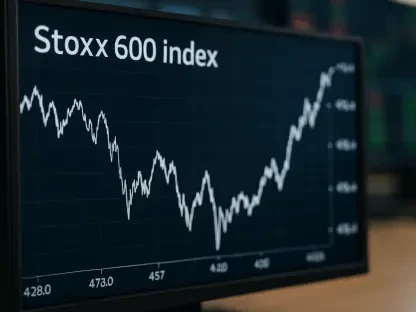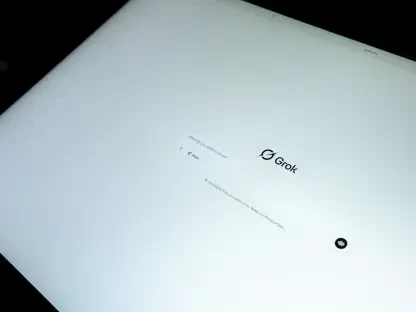Procter & Gamble (P&G) has showcased its resilience amid global economic challenges, demonstrating an adeptness in navigating shifting market conditions and evolving consumer behaviors. Despite hurdles in international markets, the company maintains a robust performance and strategic focus, particularly in developed markets like the U.S. Simultaneously, advancements in cross-border payments are transforming the financial landscape, with companies like Nium playing pivotal roles in enhancing transaction efficiency and transparency.
Economic Performance and Market Dynamics
Navigating Economic Slowdowns
P&G reported a 1% decline in first-quarter net sales, amounting to $21.7 billion. This decrease underscores the impact of economic slowdowns in critical regions such as China and geopolitical tensions in the Middle East. Despite the decline, P&G managed a 2% organic sales growth, building upon a robust 7% growth from the previous year, signaling a mixed but adaptive performance under varying market pressures. The ability to sustain any growth in the face of these significant hurdles is a testament to P&G’s strategic prowess and ability to pivot as necessary.
The volatility in China, marked by an economic slowdown, and the instability in the Middle East due to geopolitical tensions, present concrete examples of the external pressures faced by multinational corporations. As markets experience downturns, P&G’s adaptive strategies and targeted measures enable the conglomerate to hold its ground. Even in challenging times, a slight upward trend in organic growth indicates that the company continues to resonate with consumers, emphasizing the critical interplay between strategic pricing and market resilience.
Consumer Behavior and Pricing Strategies
In the U.S., consumer preferences are shifting, particularly among lower-income shoppers who are gravitating towards budget-friendly household and personal care brands. Yet, P&G remains steadfast in its pricing strategy. CFO Andre Schulten indicated that there is no immediate pressure to lower prices, reflecting the company’s confidence in its value proposition and ability to retain market share without compromising on price levels. This confidence is built upon the company’s longstanding reputation for quality, which continues to attract consumers willing to pay a premium despite broader economic challenges.
P&G’s approach to maintaining its pricing strategy, even as lower-income consumers seek out more affordable options, underscores the company’s belief in the intrinsic value of its products. This perspective not only reflects a deep understanding of its primary customer base but also highlights the effectiveness of its brand differentiation. While some companies might bend to pressure and lower prices in the face of shifting consumer preferences, P&G’s steadfast approach suggests a long-term view, prioritizing brand equity and sustained profitability over short-term gains.
Product Category Performance
Growth in Key Segments
P&G experienced growth in eight out of ten product categories. Grooming, fabric care, and healthcare products showed significant sales increases, contributing positively to the company’s overall performance. This growth highlights P&G’s strategic product placement and the effective meeting of consumer needs within these segments. The diversification across categories shows P&G’s operational excellence and ability to capture demand in various consumer segments, which is crucial for long-term sustainability.
The company’s success in these key segments reflects strategic decision-making and a deep understanding of market needs. For instance, the grooming category’s growth can be attributed to products that resonate with younger, image-conscious consumers, while fabric care growth often hinges on innovations that address contemporary household needs. Similarly, the healthcare products’ success suggests proactive industry engagement and alignment with increasing health and wellness trends. These upward trends indicate P&G’s strength in aligning its offerings with consumer expectations across diverse categories, aiding its overall market performance.
Challenges in Skincare and Beauty
Contrasting the overall growth, P&G’s skincare and beauty segments, especially the premium SK-II brand, faced notable challenges. A 20% decline in sales within this segment was primarily driven by reduced demand in China. However, the SK-II brand saw favorable performance outside China, demonstrating the geographical variability in product uptake and market-specific challenges. The performance discrepancy in skincare and beauty highlights the importance of localized strategies, as global demand can be uneven and subject to rapid shifts based on regional economic climates and consumer preferences.
P&G’s response to these challenges includes reassessing distribution strategies and marketing approaches tailored to specific regions. For example, while the Chinese market faced significant declines, exploring opportunities and consumer behaviors in other Asian markets or Western economies could offer a counterbalance. The ability to pivot quickly and adapt strategies based on localized insights is essential for managing such challenges. Moreover, continuous innovation in product offerings within the skincare and beauty segment might attract a broader customer base, mitigating geographic risks associated with market-specific downturns.
Market-specific Challenges and Strategic Responses
Strategies for Rebuilding in China
In China, P&G is actively working to rebuild distributor partnerships and adapt to changing consumer behaviors and media consumption patterns. This strategic recalibration is critical following the noted sales declines. CEO Jon Moeller expressed a confident outlook regarding P&G’s positioning in China, highlighting a commitment to long-term market strategies and adjustments to navigate external market conditions effectively. This includes leveraging digital platforms and influencers to reach the tech-savvy Chinese consumer base, aligning marketing strategies with the prevailing digital consumption trends in the region.
Reestablishing distributor relationships in China involves a deeper understanding of the local market dynamics and consumer psyche. By fostering stronger ties with reliable distributors, P&G aims to ensure that its products are not only widely available but also effectively marketed. Furthermore, as media consumption patterns shift towards online platforms, P&G’s adaptability in utilizing social media, e-commerce, and digital marketing is pivotal. The company’s strategic recalibration reflects a nuanced understanding of the Chinese market, which remains a critical area for potential growth despite present challenges.
Stability and Growth in North America
In the North American market, P&G reported a 4% increase in volume growth, gaining market share in eight out of ten categories. This robust performance underscores the company’s strong foothold in its largest market. The ability to maintain unit volume growth at higher price levels showcases P&G’s successful consumer value proposition and market resilience in a developed economy. The consistency in North American performance highlights P&G’s strategic strengths and consumer trust, vital elements in sustaining market leadership in one of the world’s most competitive environments.
P&G’s success in North America can be attributed to its continuous innovation, effective marketing, and a clear understanding of consumer needs. The volume growth against higher price points suggests that consumers perceive the value in P&G’s offerings, reinforced by targeted marketing campaigns and loyalty programs. This resilience is particularly important as the company navigates global economic uncertainties. A stable and growing base in North America provides the financial foundation to support and expand its presence in more volatile international markets, ensuring overall stability and growth.
Future Outlook and Strategic Focus
Sales Growth Projections
Looking ahead, P&G has set an optimistic sales growth forecast of 2% to 4% for fiscal 2025. This outlook includes an anticipated organic sales growth of 3% to 5%. The company aims to leverage all growth drivers, particularly in the U.S., where it identifies significant untapped consumer opportunities valued at approximately $5 billion. This ambitious yet realistic forecast underscores P&G’s strategic confidence and the comprehensive understanding of its market dynamics, which are essential for setting and achieving growth targets.
To meet these projections, P&G plans to harness its extensive market intelligence and consumer insights, continually innovating its product lines to align with evolving consumer preferences. By identifying and targeting untapped opportunities within the U.S. market, the company aims to solidify its dominant position while exploring new avenues for revenue generation. The focus on sustained organic growth reflects P&G’s strategic commitment to long-term value creation, emphasizing innovation, strategic market expansion, and effective consumer engagement.
Leveraging Technological Advancements
In line with its growth projections, P&G plans to incorporate technological advancements and innovative practices to enhance product offerings and market reach. This strategic focus on leveraging technology aligns with contemporary trends and consumer expectations, further fortifying P&G’s market position. Embracing technological innovation not only enhances operational efficiency but also ensures the delivery of superior products that meet the ever-increasing demands of modern consumers.
P&G’s investment in technology encompasses several aspects, from digital marketing and e-commerce platforms to advanced manufacturing techniques and sustainable product innovations. By integrating cutting-edge technology across its operations, P&G aims to enhance customer experiences, streamline supply chains, and reduce environmental impact. This forward-looking approach ensures that the company remains competitive in an increasingly tech-driven market landscape, positioning itself as a leader in both product quality and operational excellence.
Innovations in Cross-Border Payments
Addressing Cross-Border Payment Complexities
The traditional cross-border payment process involves multiple intermediaries and fragmented messaging standards, often resulting in slow, costly, and opaque transactions. This complex system has been likened to the “proverbial game of telephone,” where discrepancies between sent and received amounts are common. Companies operating in the global market face significant challenges due to these inefficiencies, impacting cash flow and operational cost-effectiveness. As businesses expand internationally, an efficient cross-border payment system becomes increasingly critical for seamless commercial operations.
The inherent complexities of traditional cross-border payments have long been a pain point for businesses engaged in international trade. The necessity to navigate through various banking systems, currency exchanges, and regulatory frameworks introduces both delays and potential errors in transaction amounts. Addressing these challenges is paramount to improving global trade efficiency and reducing operational costs. As such, the pursuit of innovative solutions to streamline cross-border payments holds significant promise for enhancing overall economic activities and operational transparency.
Technological Solutions and Standardization
Nium seeks to revolutionize cross-border payments through real-time verification and a global payment network. By simplifying complexities and optimizing cash flow, Nium aims to provide a transparent and efficient payment process. The adoption of ISO 2022, a common messaging standard, is vital for enhancing transparency and efficiency in the global payments ecosystem. Standards like ISO 2022 facilitate more straightforward and coherent communication between financial institutions, reducing the risk of errors and increasing the speed of transactions.
Implementing real-time verification and a global network mitigates traditional drawbacks such as costly delays and procedural opacity. Nium’s solutions are designed to address the pain points in traditional systems by offering faster, more transparent transactions. The common messaging standard like ISO 2022 plays a crucial role in this transformation by ensuring consistent and accurate information across various financial entities. This brings a level of coherence and efficiency previously unattainable, thus empowering companies to make more effective financial decisions in a time-sensitive environment.
Nium’s Role in Payment Innovation
Real-Time Payment Solutions
Nium offers real-time payment solutions, enabling interoperability between various payment schemes with its extensive network and API connectivity. This service provides access to 100 currencies across 220 markets, allowing financial institutions to streamline their processes while maintaining transparency and regulatory compliance. By reducing intermediaries, Nium’s solutions are more cost-effective and transparent, evidenced by their Swift GPI integration. This reduction in intermediaries not only cuts costs but also minimizes the potential for errors and delays, which are common in traditional cross-border payment systems.
The ability to offer real-time payment solutions across multiple currencies and markets significantly enhances the efficiency of international transactions. Nium’s integration with Swift’s GPI tracker ensures that transactions are traceable and transparent, further building trust among users. Financial institutions benefit from streamlined processes and improved cash flow management, crucial for maintaining competitiveness in the global market. Nium’s innovative approach exemplifies how leveraging technology can transform complex financial operations into more manageable and efficient workflows.
Ensuring Regulatory Compliance
Procter & Gamble (P&G) has proven its ability to thrive despite global economic challenges, showcasing remarkable skill in adjusting to changing market conditions and evolving consumer behaviors. The company’s strong performance and strategic focus, particularly in mature markets like the U.S., highlight its resilience. P&G continues to perform robustly even as it faces difficulties in international markets.
Parallel to this, advancements in cross-border payments are reshaping the financial landscape. Companies such as Nium are playing crucial roles in making transactions more efficient and transparent, which is increasingly important in our interconnected global economy. With technology streamlining the process of international payments, businesses can operate more smoothly across borders. This progress not only facilitates better financial operations but also enhances the ability of companies to manage and grow their international supply chains and customer bases.









